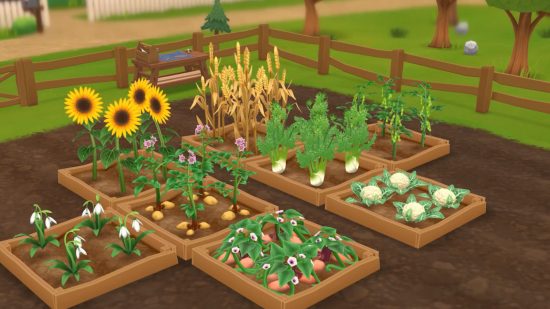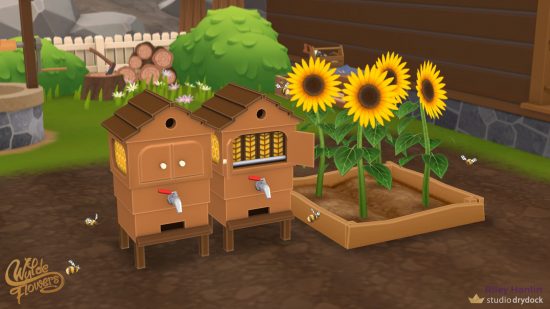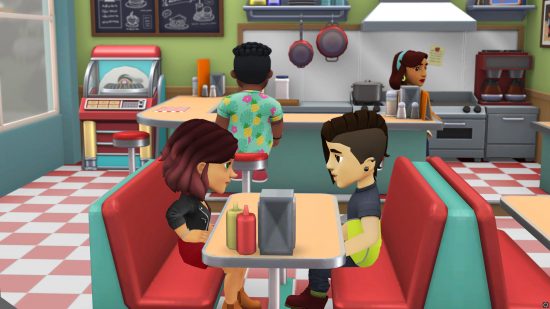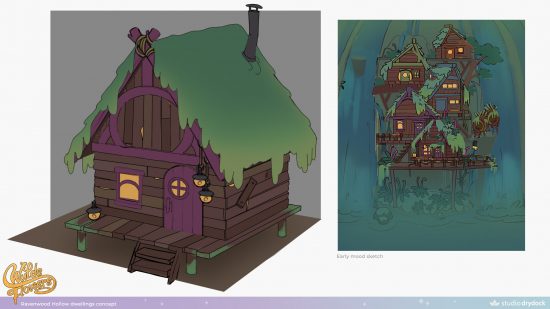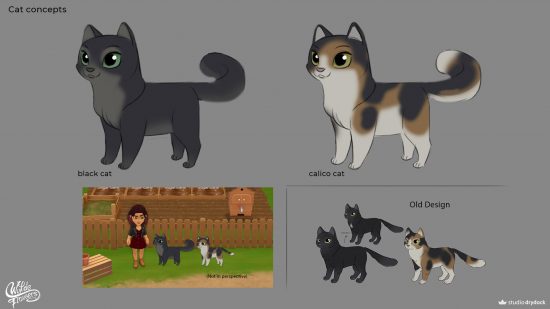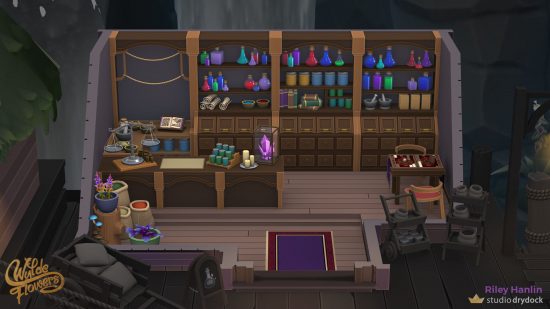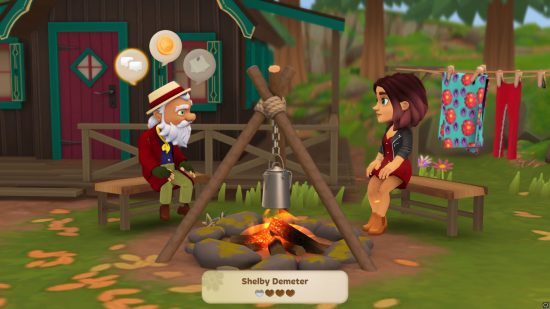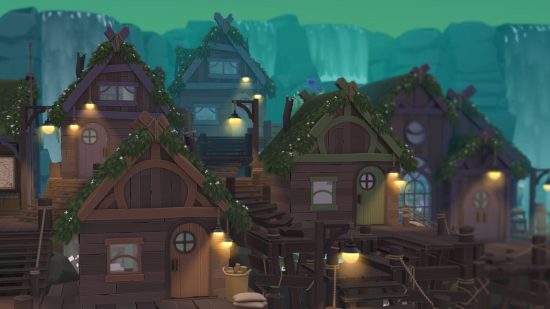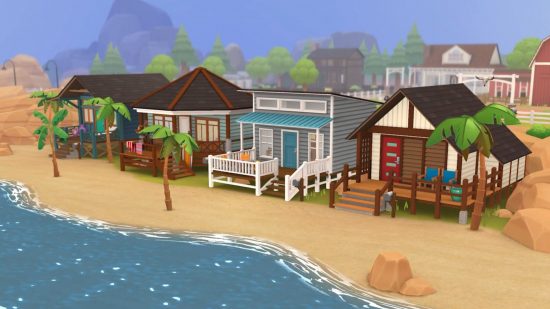There are heaps of exciting indie titles on the cards this autumn, and one we’ve been looking forward to for some time is the spellbinding farming sim, Wylde Flowers. This bewitchingly cosy game garnered plenty of popularity in its Apple Arcade release and has since hopped on its broomstick, flying to PC and Switch.
Boasting a mysterious tale of friendship and magic, a delightfully diverse cast of quirky characters, and plenty of charmingly chill vibes, we couldn’t help but fall in love with this sweet little gem – and we hope you’ll feel the same. In the lead-up to its multi-platform release, we were lucky enough to be presented with the opportunity to talk to the talented and creative minds behind this enchantingly cosy life sim.
We had plenty of questions for concept artist Iona Vorster and environment artist Riley Hanlin regarding the design process, how they went about creating such a magical experience, the process of building a wonderfully witchy world from the ground up, and the strive for inclusion and diversity in gaming. So grab a cup of restorative moonflower tea, it’s time to dive in.
The main thing that makes Wylde Flowers so special is the relaxing, welcoming world it envelopes you in, and it’s clear that this was a big part of Studio Dryrock’s design process. In fact, Iona confirms that ‘creating a relaxing and welcoming, friendly world was one of [their] key goals’, and that above all, despite the mystery and adventure woven into the story, they ‘wanted a place for players to feel safe’.
One of the ways they achieved this was in their use of sanded-off edges, something Iona notes as a valuable piece of art direction from creative director Amanda. She goes on to say that they ‘didn’t want anything in the game to look sharp or pointy’, focusing instead on ‘rounded-off edges and friendly, chunky shapes’. She also credits the choice of colour palettes as ‘really important in creating that sense of not only harmony but warmth throughout the environment and characters’.
With the rich sense of life apparent throughout Wylde Flowers, we were curious as to whether the devs took any inspiration from real-life locations, cultures, or folklore in order to bring the environments and characters to life. Iona confirms that ‘for the characters, [they] definitely did’, going on to elaborate that ‘every character in Wylde Flowers has an extremely detailed backstory written by narrative lead Desiree’.
She explains that ‘all of that information, whether written into the story or visualised in the character concepts, was researched and based on real cultures, or in the case of a character like Aryel, folklore.’ To ensure they were ‘accurate and respectful’ in their representation, they also worked with cultural consultants – a thoughtful touch that acts as a testament to the thorough reverence of Studio Dryrock and the Wylde Flowers development team.
Leading on from this topic, Iona states that ‘inclusivity was always at the top of the list when designing Wylde Flowers’, highlighting that ‘it’s an absolutely core part of the game’. She explains that they ‘built Wylde Flowers for people that don’t often get to see themselves represented in games’ and those that rarely get to see games ‘specifically created for them’.
With Wylde Flower displaying such a focus on inclusivity, we had to ask Iona and Riley about whether they think the games industry as a whole is moving in the right direction. Riley believes that ‘there’s been a recent positive shift’, suggesting that ‘we’re just at the beginning of seeing things change, and the success of games like Wylde Flowers is a great step forward’. Iona agrees that ‘we’re starting to see some parts of the industry pushing in the right direction now’, but urges that ‘there’s always more to do’, expressing her hope that things will ‘continue to improve’.
Regarding the character and environment design of Wylde Flowers, we were curious whether it remained close to their original concept work, or whether it evolved over time. Riley explains that ‘many elements of the game changed and evolved throughout the production’, but ‘there wasn’t a lot of environment concept art’, with more of a ‘style guide’ for artists to follow.
She goes on to state that Ben O’Reilly was the first 3D artist on the team, and by the time Riley joined, he’d created the whole town. This gave the rest of the environment artists a great point of reference when building the other areas. Interestingly enough, Riley believes that ‘the aspect of the 3D art that changed the most was the foliage – the plants and trees went through a few iterations because [they] couldn’t use transparency on [their] textures because it affected performance’. This was a huge undertaking considering, as the name suggests, half of the game is plants!
When it comes to the overall character design, Iona reminisces that they ‘went through a few iterations towards the beginning of development’, stating that ‘the initial direction [she] took for the characters was less stylised and exaggerated’. However, the team decided that this wasn’t the right direction for Wylde Flowers, favouring a more expressive style, especially through their facial animations.
At this point, the team ‘explored a wide range of different options focusing on stylisation and proportion’ before landing on the current look. After nailing that down, the design didn’t change all that much, though Iona did have to redraw some early characters to bring them in line with the new style.
We were also curious about the creative process – did they design characters and environments first and base the story around them, or vice versa? In Iona’s opinion, the short answer is ‘a bit of both’. There was ‘already some story’ when 3D artist Ben O’Reily made a start on building the environments and Iona started developing the character look.
Then, when narrative designer Desiree Cifre joined the team, ‘she completely wrote the story from start to finish, as well as creating the giant character biographies’. From this point, as more people joined the team and later art was developed, the ‘story was firmly in place’ and they ‘used it to inform all [their] design choices’, from characters to new environments, and even for props like the town statue.
When it comes to imbuing the 3D models with a sense of character and creating a design to match their personality, Iona states that it ‘really starts with the narrative design of a character, and having a proper sense of who they are as a person’. In fact, there were ‘a lot of times [she] didn’t have to create too many concept variations of a character, since [she] could clearly picture them in [her] head just from reading their backstories.’ After that, it’s ‘just a matter of bringing that sense of a real personality to the other steps of the pipeline, which character modeller Soo-Ling and animator Mike were magicians at doing’.
Each of the Wylde Flowers characters have their own home and many have their own shops in the village, which perfectly reflects who they are as a character. When designing these, Riley found that ‘one of the best things about working in an indie studio is that you get to work with pretty much everyone’, explaining that they ‘had character sheets for each character, so when [they] designed their homes or shops [they] had heaps to work with, but also had access to the people who actually wrote those characters.’
From there, Riley found that it was ‘hard not to create your own little narratives when you’re creating environments’, as you ask yourself ‘how was that pot knocked over? Would it have been cleaned up?’. She believes that ‘creating your own scenes within a scene gives more personality and reinforces the feeling that these people live here’.
After spending so many hours exploring the wonderful world of Wylde Flowers, it’s amazing to hear about the creative process behind the game. Riley found that one of her favourite parts of production was the process of ‘seeing words turn into concepts, to these funny little greybox characters [they] call jellybeans, and then into these amazing characters’. She found herself always looking forward to talking to the jellybeans because they ‘had some funny placeholder lines while the writers were creating the real ones’.
Another fun anecdote from Riley’s time working on the game revolves around Ravenwood Hollow at a time when they ‘only had concepts for the characters’. She explains that ‘Westley was quite tall in werewolf form’ and ‘Peri had these awesome wings’, which may sound cool, but of course, she ‘had to create practical environments for them’ – which is a much tougher task than it may seem. She ‘ended up taking some of the characters [they] already had and stretching them out to emulate the new concept characters so [she] could at least build doorways’, ending up with her having character artist, Soo-Ling, in stitches.
As we mentioned above, Wylde Flowers started as an Apple Arcade game, and has now made its way onto PC and Switch. We were curious as to whether the team faced any challenges when bringing Wylde Flowers to multiple platforms, to which Riley replied ‘actually on the art side we haven’t had to change much’, explaining that they ‘built the game for all Apple devices so it looks great on 4K TVs as well as tiny phone screens’. As a result, they ‘had to add in a few extra polygons here and there, but nothing too extreme’.
With such a dedicated and passionate team and so many interesting individuals to meet in Wylde Flowers, we had to ask whether Iona and Riley had a favourite character and, if so, why. Riley confirmed that everyone on the team has a favourite and she personally loves all the characters, but, overall, Shelby is her favourite. ‘He always has the most intriguing dialogue – you never quite know “when” he is talking about’ she explains. ‘He’s also super sweet when you gift him his favourite things and I just love his whole look!’
Iona agrees that everyone definitely has their favourite, going on to highlight that it’s pretty tough not to – all of us at PT certainly do. Iona has worked so closely on the characters that she finds it hard to pick just one favourite, but she will ‘always have a soft spot for Hazel’ due to the fact that ‘she’s more than a little mischievous’, stating ‘I hope I can be half as cool when I’m her age!’ We have to agree – Hazel is an absolute gem.
Working on a heartfelt project like Wylde Flowers in such a small team has got to be a truly memorable experience, with plenty of victories and challenges along the way. We wanted to hear about Riley and Iona’s personal favourite part of the journey, and what made it special for them.
Riley states that working on Ravenwood Hollow was easily her favourite part of production, as ‘being given an entire fantasy village is an environment artist’s dream’. She recalls her very first team meeting in which Iona showed off the concepts for Ravenwood Hollow, and Riley found herself in awe of how cool it looked. She ‘couldn’t have imagined in that moment that [she] eventually would be the one who got to make it’, going on to say that ‘Iona and I actually got to work on that area together and it was a lot of fun sharing ideas’.
On the other hand, Iona loved being able to work on all the different aspects, including characters, environments, designing VFX, and even things like lighting. However, she credits her favourite part of the journey as working with the Wylde Flowers team. She explains ‘everyone is so talented and passionate, but most importantly friendly and kind’, concluding that ‘it’s been one of the best experiences of [her] career so far’.
Naturally, we had to ask what’s in store for the future of Wylde Flowers and Studio Dryrock as a whole, to which creative director Amanda Schofield replied ‘Riley and Iona are busy building some truly special content updates we can’t wait to tell you about’, assuring that we can look forward to hearing all about them after the Switch and PC release on September 20.
Wylde Flowers is a truly magical game, and this opportunity to take a peek behind the curtain reveals just how passionate the team are, solidifying its firm place in our hearts. We want to extend a massive thank you to Iona and Riley for taking the time to chat with us and sharing such wonderfully in-depth answers, it’s been a real treat.
To see more from the lovely ladies we chatted with here, check out Riley and Iona‘s Art Station accounts. You can pick up a copy of Wylde Flowers on Steam or the Nintendo eShop from September 20, 2022, or, if you want to find out more before you buy, check out our Wylde Flowers review.
